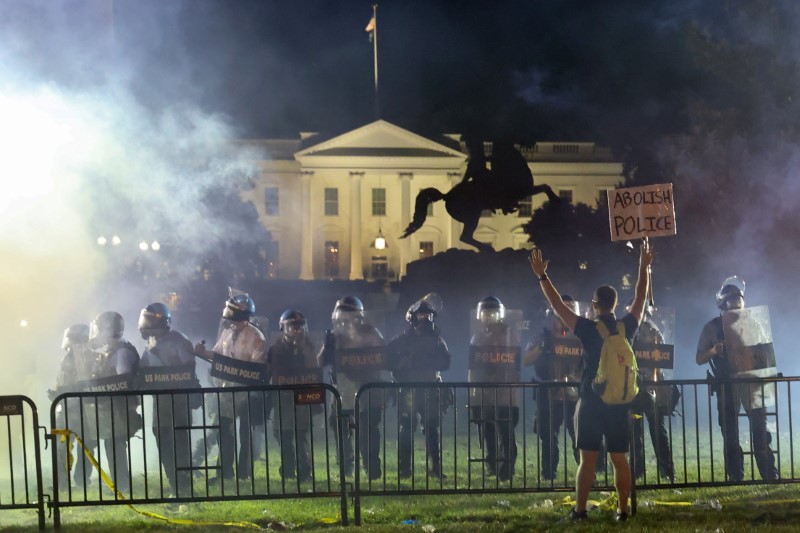
By Jonathan Ernst and Brendan O’Brien
WASHINGTON/MINNEAPOLIS (Reuters) – U.S. protesters ignored curfews overnight as they vented their anger over the death of an unarmed black man at the hands of police, but there was a marked drop in the violence that led President Donald Trump to threaten to deploy the military.
George Floyd died after a white policeman pinned his neck under the officer’s knee for nearly nine minutes in Minneapolis on May 25, reigniting the explosive issue of police brutality against African Americans five months before the November presidential election.
Tens of thousands of people took to the streets of cities coast to coast for an eighth night as National Guard troops lined the steps of the Lincoln Memorial in Washington.
There was sporadic violence in Washington and Portland, Oregon, with protesters tossing fireworks and bottles answered by police flash grenades and tear gas.
Clashes between protesters and police and looting of some stores in New York City gave way to relative quiet in the early hours of Wednesday. Police told media they made 200 arrests, largely for curfew violations.
In Los Angeles, many demonstrators who defied the curfew were arrested, but calm had been restored by mid-evening to the extent that television stations switched from wall-to-wall coverage back to regular programming.
Large marches and rallies also took place in Philadelphia, Atlanta, Denver and Seattle.
The officer who knelt on Floyd, Derek Chauvin, 44, has been charged with third-degree murder and second-degree manslaughter. Three other officers involved in the incident were fired but have not been charged.
‘SILENCE IS VIOLENCE’
Although rallies on behalf of Floyd and other victims of police brutality in recent days have been largely peaceful, many have turned to vandalism, arson and looting after dark. On Monday night, five police officers were hit by gunfire in two cities.
Outside the U.S. Capitol building on Tuesday afternoon a throng took to one knee, chanting “silence is violence” and “no justice, no peace,” as officers faced them just before the government-imposed curfew.
Many of the protesters used the slogan “take a knee”, referring both to how Floyd died and a long-standing protest against racism in America that started in 2016 with a football player taking a knee instead of standing during the National Anthem.
The crowd remained after dark, despite the curfew and vows by Trump to crack down on what he has called lawlessness by “hoodlums” and “thugs,” using National Guard troops or even the U.S. military if necessary.
The Republican president, who is seeking re-election in November, continued his hard-line rhetoric, urging police to “get tough” in a series of tweets on Wednesday, a day after his likely challenger former Democratic Vice President Joe Biden vowed to heal the nation’s racial divide.
In Atlanta, four police officers and two former officers were charged with using excessive force while arresting two students. Minneapolis launched an investigation into possible discriminatory practices in the police department over the last 10 years.
In New York, thousands of chanting protesters ignored the curfew to march from the Barclays Center in Flatbush toward the Brooklyn Bridge as police helicopters whirred overheard.
The crowd halted at an entrance to the Manhattan Bridge roadway, chanted at riot police: “Walk with us! Walk with us.”
New York state police arrested a 30-year-old woman Tuesday after she drove a car striking three police officers at a demonstration in Buffalo on Monday.
On Hollywood Boulevard in Los Angeles, hundreds of people filled the street, marching past famous landmarks of the film industry. Others gathered outside Los Angeles Police Department headquarters downtown, in some cases hugging and shaking hands with a line of officers outside.
Los Angeles was the scene of violent riots in 1992, following the acquittal of four policemen charged in the beating of black motorist Rodney King, that saw more than 60 people killed and an estimated $1 billion in damage.
The past week’s demonstrations have reverberated outside America, and a growing chorus of companies, celebrities and athletes have also denounced Floyd’s death and urged change.
In Rome, Pope Francis called for national reconciliation in the United States, saying that while racism is intolerable, the street violence that has broken out is “self-destructive and self-defeating”.
A Reuters/Ipsos poll released on Tuesday found a majority of Americans sympathize with the protesters.
The survey conducted on Monday and Tuesday found 64% of American adults were “sympathetic to people who are out protesting right now,” while 27% said they were not and 9% were unsure.
In Minneapolis, Roxie Washington, mother of Floyd’s six-year-old daughter, Gianna, told a news conference he was a good man.
“I want everybody to know that this is what those officers took from me …,” she said, sobbing. “Gianna does not have a father. He will never see her grow up, graduate.”
(Reporting by Reporting by Daphne Psaledakis, Anne Saphir, Brendan O’Brien, Nathan Layne, Brad Brooks, Diane Craft, Jonathan Allen, Sharon Bernstein, Dan Whitcomb, Aakriti Bhalla, Rich McKay and Philip Pullella; Editing by Nick Macfie and Paul Simao)










